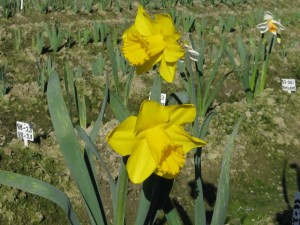Hi Daffnetters,
Another photo of this deep gold yellow trumpet.
I didn,t realise quite how early it was , I knew P. R. was not breeding early flowers and that it was
a selection from a cross that would hopefully give some fine show trumpets.
I put it in with the late lines and it went through the H W T in mid April , quite late for N Z treatment.
It also recieved a generous full 3 hours in the tank at a high end temperature.
The leaf and stem markings and slight distortions are absolutely classical H W T symptoms.
Late varietys that had the same treatment are now emerging , also showing H W T damage , but not as severe
as the early trumpet given a hot bath when it had obviously started its growth cycle.
Almost all that planting is similar , — but I tell them that they, ll thank me for it next season.
Alls well that ends well ….
Cheers John


Keith,
Are saying that it gets so hot in Texas that the soil around the bulbs, which are maybe 8″ underground, will reach HWT temperatures? HMMMM back at you.
Donna
Theodore E. Snazelle, Ph.D.
101 Water Oaks Drive
Clinton MS 39056-9733
—